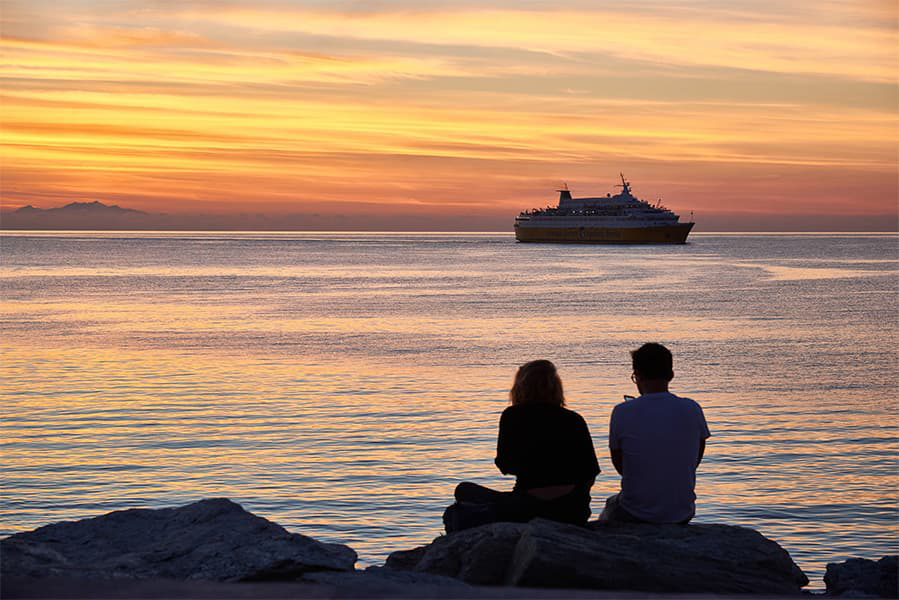Jeju – Chuja
Ferry to Chuja Island
Jeju – Chuja
Ferry to Chuja Island

The Jeju Chuja ferry route is currently not sailing. Jeju Chuja sailing durations and frequency may vary from season to season. View our Deal Finder for alternative routes and compare prices, times and schedules.
More routes than anyone else.

Compare fares, times & routes in one place.
Change plans easily with flexi tickets.

Book e-tickets & manage trips in-app.
Live ship tracking & real-time updates.

Top-rated customer support when you need it.
Found across the Sea of Japan that stretches along the southern coast of South Korea is the volcanic island of Jeju. This oval shaped landmass, known as the “Island of Gods” due to legends that claim the islanders are the distant descendants of demi-Gods, is blessed with year-round warmth, beautiful white sand beaches, and a thriving, emerald-green landscape dominated by the cloud-covered peak of Mount Hallasan. Not only is the sub-tropical island a popular destination for love-struck newly-weds, it is also a treasure trove of natural wonders. The Manjanggul Lava-tube, found within a cave on the north coast, is an astounding 20-metre high column of solidified magma that is listed as a UNESCO World Natural Heritage site. Another spectacle is the Cheonjiyeon Waterfall (translated literally as “sky connected with land”). Here spring water, pooled atop a rocky outcrop, cascades into an artificial pond illuminated at night by a series of underwater lamps. The port of Jeju is found in the sprawl of Jeju City on the island’s northern coast. This facility, located at the edge of the Geonip-dong district in the very heart of the city, is relatively small; it consisting of little more than a few piers that jut in a saw-tooth fashion from the shoreline and into the sea. The ferry terminal is located on one of the largest and westernmost of these piers. It is home to a handful of passenger amenities including a compact car-park, an indoor waiting room, toilet facilities, a tourist information booth, and a small café selling food and drink. Due to the port’s location near the city centre, it is well supported by a number of transport links. Though it can be easy to get lost in the maze of streets that cut between the modern apartment blocks and skyscrapers, a few main road routes lead directly from the downtown districts to the rolling, rural outskirts. An extensive system of inner city buses regularly whisks passengers through Jeju City from stops near the harbour; while another, more expansive service offers routes into the surrounding area - including to the nearby international airport. A number of routes currently leave from the port in Jeju a few times throughout the week. Services hosted by Hanil Express sail north out from the mouth of the harbour to the port of Chuja island and the mainland town of Wando on South Korea’s shattered southern coast, both a short distance across the ultramarine waves of the Sea of Japan.
Found off the south-western coast of South Korea, just beyond the ragged mosaic of islands that pock the Yellow Sea, is the Chuja Island archipelago. Though consisting of 42 landmasses, ranging from small atolls to bigger islands, only 4 are inhabited; the largest of which being Sangchujado – home to the portside town of Sinyang-Ri. Those approaching Chuja by boat will first notice the magnificent tree-topped peaks that almost completely cover the island. These steep hills rise up on chalk-coloured cliffs that overlook the deserted islands found in the exotic waters of the Jeju Strait. Chuja port is situated within a natural blue-watered bay on the western shores of the main island, equidistant between the large volcanic island of Jejudo in the south and the South Korean mainland town of Wando to the north. It’s a prime location for travellers eager to explore the sparsely populated southern reaches of the South Jeolla Province. Transport to and from the port is limited, though all four of the inhabited areas are connected by a simple road system that snakes along the coastline. The port itself is very small and devoid of passenger facilities meaning the harbour is far more suited to the mooring of barges and yachts than servicing cruise ships. Two routes, both operated by Hanil Express ferries, take passengers from Chuja to either Jejudo in the south or Wando in the north. These short voyages run a number of times throughout the week.